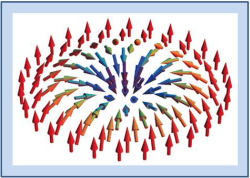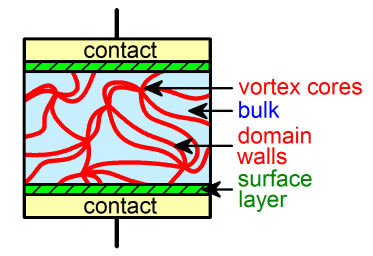
Our research in this field aims to unravel the physics of topologically protected structures arising in correlated matter like skyrmions and ferroelectric domain-wall vortex cores, both promising new functionalities of correlated matter that could pave the way for future advances in microelectronics.
1. Skymion host materials
Skyrmions, whirl-like spin objects, in recent years have attracted tremendous interest from both an academic and technological point of view. We investigate new types of skyrmion-lattice states that are stable in a large parameter space. Skyrmion-host materials often show non-canonical polar states and magnetoelectric effects which can be investigated by dielectric spectroscopy. For example, we found that the skyrmion-lattice state can be dressed with ferroelectric polarization [1,5,6]. In general, multiferroic skyrmion systems may enable the dissipation-free electronic control of these nanometer-sized objects, which is crucial for skyrmion-based memory devices.

|
Neel-type skyrmion |
2. Vortex-like ferroelectric domain patterns
We also investigate vortex-like ferroelectric domain patterns, where the vortex cores represent stable topological defects, as occurring in hexagonal manganites. These stable topological objects may be of high relevance for the design of new domain-wall-based microelectronic devices. A detailed equivalent-circuit analysis of dielectric spectra can reveal the intrinsic conductivity properties of the ferroelectric domain walls forming these vortex cores [4].

|
Schematic sample cross section in a hexagonal manganite indicating different regions, including ferroelectric vortex cores [4]. |
3. Some relevant publications from our group:
| [1] | Multiferroicity and skyrmions carrying electric polarization in GaV4S8 E. Ruff, S. Widmann, P. Lunkenheimer, V. Tsurkan, S. Bordács, I. Kézsmárki, and A. Loidl, Science Advances, 1, E1500916 (2015). [PDF] |
| [2] | Magnetoelectric effects in the skyrmion host material Cu2OSeO3 E. Ruff, P. Lunkenheimer, A. Loidl, H. Berger, and S. Krohns, Sci. Rep. 5, 15025 (2015). [PDF] |
| [3] | Polar dynamics at the Jahn-Teller transition in ferroelectric GaV4S8 Z. Wang, E. Ruff, M. Schmidt, V. Tsurkan, I. Kézsmárki, P. Lunkenheimer, and A. Loidl, Phys. Rev. Lett. 115, 207601 (2015). [PDF] |
| [4] | Conductivity Contrast and Tunneling Charge Transport in the Vortexlike Ferroelectric Domain Patterns
of Multiferroic Hexagonal YMnO3 E. Ruff, S. Krohns, M. Lilienblum, D. Meier, M. Fiebig, P. Lunkenheimer, and A. Loidl, Phys. Rev. Lett. 118, 036803 (2017). [PDF] |
| [5] | Polar and magnetic order in GaV4Se8 E. Ruff, A. Butykai, K. Geirhos, S. Widmann, V. Tsurkan, E. Stefanet, I. Kézsmárki, A. Loidl, and P. Lunkenheimer, Phys. Rev. B 96, 165119 (2017). [PDF] |
| [6] | Optical, dielectric, and magnetoelectric properties of ferroelectric and antiferroelectric lacunar
spinels K. Geirhos, S. Reschke, S. Ghara, S. Krohns, P. Lunkenheimer, and I. Kézsmárki, Phys. Status Solidi B 259, 2100160 (2022). [PDF] |